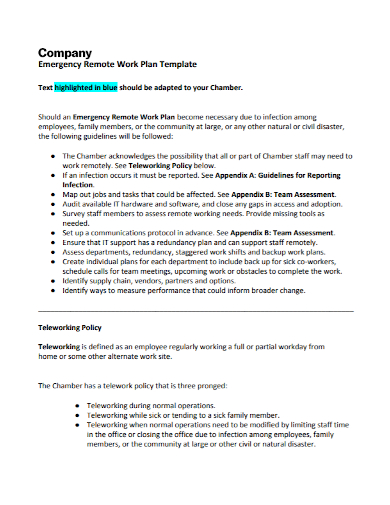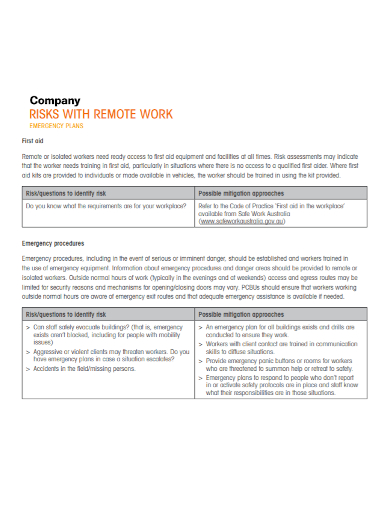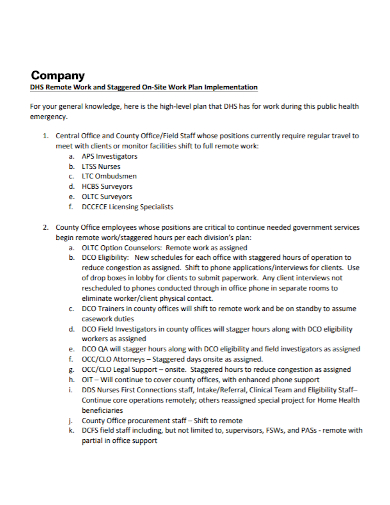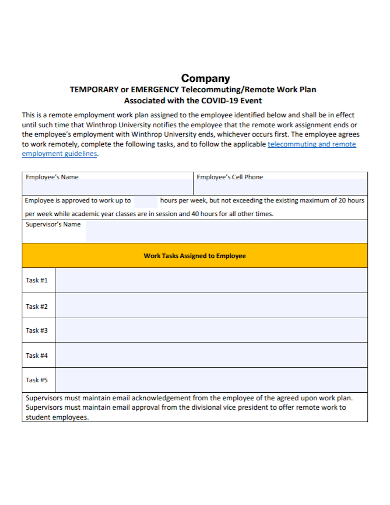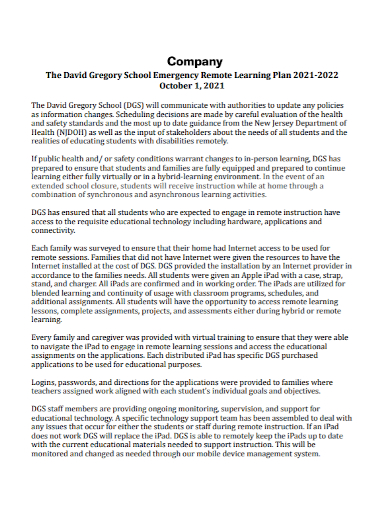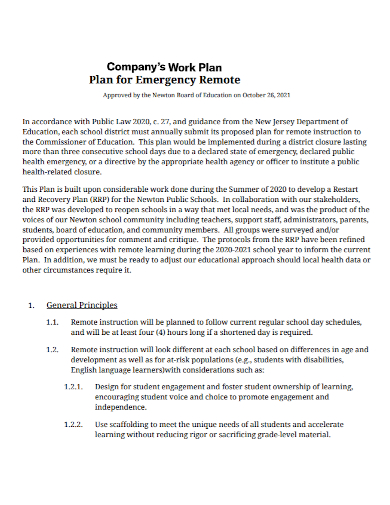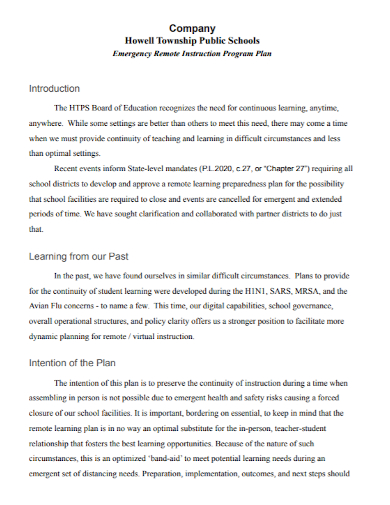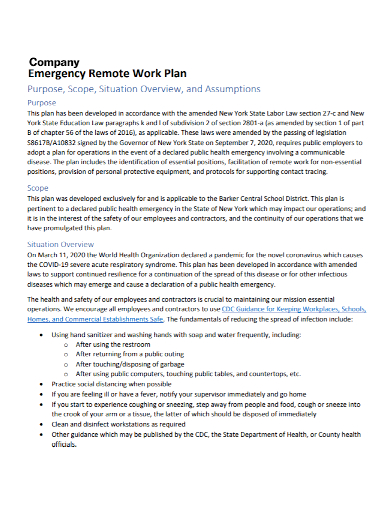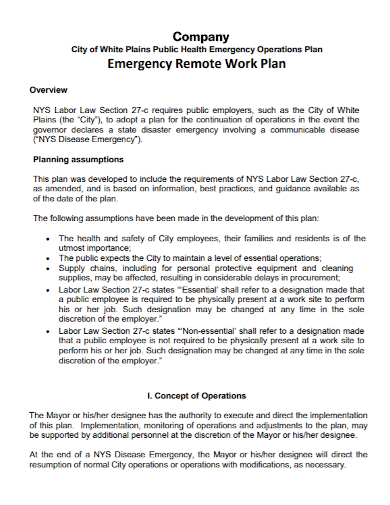Remote work has become increasingly popular during the start of the COVID-19 pandemic which prompted a lot of companies to temporarily prevent their employees from physically going to work. Risk of any kind which can affect business operations and its employees has driven companies to develop a so-called company emergency remote work plan. Management is suddenly confronted with the reality of managing their staff remotely which is a rather new undertaking for most companies who rely on staff to do their job in an office or on-site. That being said, it has become of great importance for management to come up with ways on how to manage their employee’s productivity and how to maintain the ‘business as usual’ scenario while practically everyone is working remotely. Learn and read more about this below, and to help you create an effective remote work plan check out our free company emergency remote work plan samples which are available for download on this page.
10+ Company Emergency Remote Work Plan Samples
1. Company Emergency Remote Work Plan Template
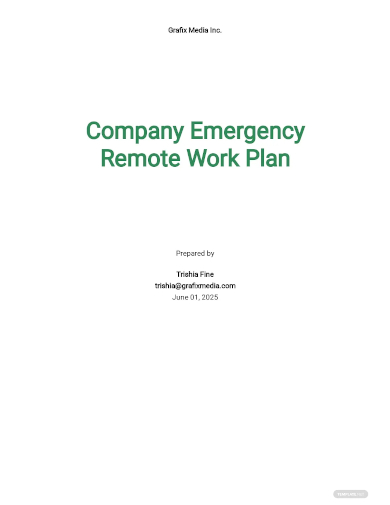
2. Company Emergency Remote Telework Plan
3. Company Risk Emergency Remote Work Plan
4. Company Emergency Remote Work Implementation Plan
5. Company Emergency Telecommuting Remote Work Plan
6. Company Emergency Onsite Remote Work Plan
7. Company Emergency Remote Learning Work Plan
8. Sample Company Emergency Remote Work Plan
9. Company Emergency Remote Program Work Plan
10. Standard Company Emergency Remote Work Plan
11. Company Emergency Operations Remote Work Plan
What Is a Company Emergency Remote Work Plan?
A lot of us didn’t expect the pandemic to escalate to a catastrophic level, and now at present with new COVID variants, the business world has still opted for some of its employees to work remotely. Now that we are currently faced with such a predicament, companies should now anticipate and acknowledge that such an emergency does exist and plans have to be made in order to create a systematic approach on how to manage employees working remotely or from home. Perhaps some companies have already started to adopt this concept but for the majority, this is something entirely new. Just like a business contingency plan, a company emergency remote work plan should be able to address different issues when it comes to remote work such as how to set up an employee’s attendance, monitor their performance, their work schedule, what equipment and support should they need and many others.
How To Develop a Company Emergency Remote Work Plan?
If a majority of your employees are used to working in the office, then a shift to remote work will have its challenges, not just for the staff but for the entire management as well. Many workers may need assistance to visualize a remote future that is liberating as opposed to isolating. Change may be hard to adapt at first, this is why careful planning is required by management. Without a system to follow this would only result in misunderstanding and discord which is dampened business operations and risk further loss. Several security issues may arise from employees not being used to working remotely. Indeed, employees sent home to work remotely in an emergency may not have been eligible otherwise. This creates security risks and other unwanted factors. Each company has its own policies and standards for its plans, so let us tackle the common factors that are needed to develop an effective company emergency remote work plan.
I. Risk Assessment
Pandemics are not the only risks that would propel companies to obligate their employees to work remotely. Natural disasters or accidents can affect normal business operations which can impose a remote work scenario. By assessing the different types of risks that can affect your company, you are then able to work better on coming up with solutions.
II. Impact Analysis
Every risk has its outcome or consequences. An impact analysis predicts the consequences of disruption of a business function and process and gathers information needed to develop recovery strategies or in this case outline actions plans on how to supervise employees in case of an emergency to ensure they are still able to work remotely.
III. Prioritize Key Business Processes
Some businesses could not afford to have all their staff work remotely. That being said it is important to identify which crucial business processes need to continue for the company to survive. Build the remote work policy around supporting those workflows.
IV. Communications Guidelines
Set up a communications plan in place when it comes to knowing how to reach each employee. It’s helpful to consolidate contact information in one place and make it well known which channels of communication employees are expected to use. A proper communication plan can also help team members reach out to other employees for concerns regarding work and other important matters.
V. IT Software and Hardware
Nowadays the most common means used for working are computers, laptops, and even smartphones. And each company has its own unique software which they use, so it is vital to educate members of the team on the importance of creating strong passwords, how to avoid email phishing scams, and other cyber security best practices, especially during this period of emergency. Also, you will need to organize which office equipment should employees take with them and make sure they are aware of the policies that go along with it.
VI. Measuring Work Performance
To ensure that employees are working just as if they are in the office, you need to be able to assess their work performance remotely. You will also need to come up with different procedures and policies on how to handle attendance and their work schedule since in some cases might end up being flexible rather than following the regular working schedule.
VII. Monitoring Your Plans
It is important that even during the course of the emergency to monitor if the emergency remote plans you have implemented are working as planned. Take note of the different problems so you may be to implement alternatives that can make remote work easier for your employees.
FAQs
What Is an Emergency Preparedness?
As the term suggests these are the initiatives you take to make sure you are safe before, during, and after an emergency or natural disaster.
What Is a Business Continuity Plan?
This is a document that involves creating a system of prevention and recovery from potential threats to a company.
What Is a Remote Work Policy?
These are different guidelines that contain details about how to go about working remotely. This includes expectations of working hours, legal rights, and cybersecurity requirements.
Emergencies often happen when we all least expect them. If it does occur, we sometimes have little time to prepare which is why businesses must start developing a company emergency work plan. This will help your employees adjust to working remotely and ensure that the company continues to operate normally.
Related Posts
FREE 9+ 30-Day Marketing Plan Samples in PDF | MS Word | Apple Pages | Google Docs
FREE 3+ Sales Team Action Plan Samples in PDF | MS Word | Apple Pages | Google Docs
Marketing Plan For Small Business Samples
FREE 7+ Fashion Business Plan Samples in PDF
FREE 10+ Sprint Planning Samples In MS Word | Google Docs | PDF
FREE 10+ Wedding Planning Samples in MS Word | Apple Pages | Powerpoint | PDF
FREE 9+ Monthly Study Planner Samples in PSD | Illustrator | InDesign | PDF
FREE 9+ Sample Curriculum Planning Templates in PDF | MS Word
FREE 10+ Teacher Development Plan Samples in MS Word | Google Docs | Apple Pages | PDF
FREE 10+ Basketball Practice Plan Samples in PDF
FREE 12+ School Business Plan Samples in PDF | MS Word | Apple Pages | Google Docs
FREE 7+ Client Strategic Plan Samples in PDF | MS Word
FREE 11+ Trucking Business Plan Templates in PDF | MS Word | Google Docs | Pages
FREE 7+ Small Hotel Business Plan Samples PDF | MS Word | Apple Pages | Google Docs
FREE 14+ Bakery Business Plans in MS Word | PDF | Google Docs | Pages

